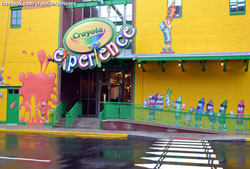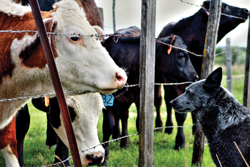This past weekend I went to the Crayola Experience, in Easton, PA, with my little cousin Amanda. Walking around the incredible building all I saw were bright colors and tons of innovative arts and crafts for kids to do.
While Amanda was making her very own crayons, including one named “Daddy” for her number one supporter, my Uncle Justin, I realized that I don’t get to do these fun things anymore. I don’t have a use for crayons, clay or multicolored markers now.
Why is it that once students start their college career, they stop utilizing our creative and expressive outlets? I’m talking about drawing, photography, painting, and the like. Some of these hands-on learning methods, drawing in particular, are extremely useful in difficult courses such as math and science.
Drawing assignments out can be a useful tool in logical courses. Whereas using paint and photography are useful in classes such as history and geography, visual comprehension is important in many courses. Aside from art majors, Monmouth requires three credits in an aesthetic course for other majors. It would be beneficial to see creative projects or any type of creative freedom incorporated into other more intense, non-intro, courses.
According to the Adobe State of Create global benchmark study, approximately 62 percent of Americans feel that our creativity is being stifled by our education system(s). That is over half of the population. This is an overwhelming number considering that almost every American is able to attend school and experience it at some point in his/her life. In addition, 85 percent of Americans believe that “creativity begins with expressing my ideas.”
The majority of classes assign papers, journal entries, etc. solely based on their guidelines and prompts. This would lend to the idea that the education system “stifles” students’ creativity.
Because students are given the outlined assignment as opposed to creating challenging prompts for themselves, students can become lazy and reliant on instruction. Therefore, when given the task to create his/her own prompt, many to most students take the easy way out, which could be a direct result of a stifled creativity environment.
Many people, professors especially, may argue that writing is a form of creative expression, but when a student has an essay due for each class in the same week, it becomes tiresome and difficult to be passionate and expressive in each one. This is especially difficult for dry writing in subjects such as science or history. The excessive utilization of writing in college courses can beat a student down and make him/her loathe the word “essay.”
Dr. Sue Starke, an associate professor of English, said, “Sometimes imitation of a form one is studying, for example, writing a sonnet in a sonnet unit—a very hard assignment, by the way—is a creative way of learning the material.” This type of writing, not exactly an essay, might be something that is useful in inspiring creativity in a literature setting.
Dr. Starke also brought up a point about higher-level classes; she said, “I think that professors assume, rightly or wrongly, that by the time a student is in a 300 or 400 level class in a college-level discipline, the sorts of ‘attention-getting’ projects designed to elicit engagement at the lower levels aren’t necessary, as students have specialized themselves by major and interest type.”
A lot of times, in intro/lower level courses, engagement can be difficult to get because these courses are mainly general education courses that are required to graduate. And, being the way it is, creative/crafty projects are a good way to gain interest/engagement.
When students get into the meat of our majors in the 300 and 400 level courses, they are already engaged and, therefore, do not need such obviously creative assignments. But, as Dr. Starke stated, mimicking forms of great works, in literature courses that is, would give the same creative effect as an obvious crafty assignment.
In contrast to what Dr. Starke was saying, Maddie Arecchi, a sophomore English and education student, said, “I think incorporating more hands-on, creative projects would be beneficial because it would be a nice mental break from lectures and they would help us to connect to the material of the course in an interesting way.”
Arecchi continued, “This would also be beneficial for the kinesthetic learners who learn best by doing.” When we are younger we discover the world by doing things and engaging in various learning activities.
Esteemed educational psychologist Jean Piaget once said, “Although the ability to abstract a concept and make complex connections between concepts are considered to be signatures of a mature mind, humans learn best by doing something concrete first, and then abstracting to more general concepts.”
By this regard, college courses have it all wrong! All of the higher education, abstract, dense studying we engage in should be supplemented by a hands-on, interactive project or experience.
Creativity gradually has less and less of an incorporation into curriculums as one gets older, when it should be incorporated more with age. If creativity was simply woven into a course’s curriculum, it could spark new interest for students in any given subject area.
Grace Ward, a sophomore business marketing and management student, said “Who knows? It could lead students into finding a new direction in a career they are passionate about. Passion is the new drive for a great career and life.”
When we graduate from college, many of us will go on to lead jobs in which creativity is a necessity. In fact, it is difficult to imagine a job that doesn’t utilize and value creativity. According to the same study above, 50 percent of Americans agree that people are increasingly being expected to think creatively at work. And, Grace is right; creativity usually leads to an enhancement of passion.
More creative freedom in science could lead to a greater passion for the subject; the same goes for any subject. Any kind of wiggle room in a subject can open up whole new avenues of work and desire in a course.
The educational system can take little steps in this more creative curriculum by implementing small changes. For example, more courses can simply give freedom of choice with assignments.
English professors could give more of a choice on the topics of essays; science professors can structure labs to be more experimental and lax, and so on. This does not necessarily mean students should start making paper mache volcanoes and overly decorated tri-folds again, but a little bit more freedom in decision making and assignment creation could go a long way.
So, after a long and tiring visit to the Crayola Experience, I have realized, with some help from my little cousin, that when one is allowed to color outside the lines, anything is possible.
PHOTO TAKEN by www.mynews13.com



